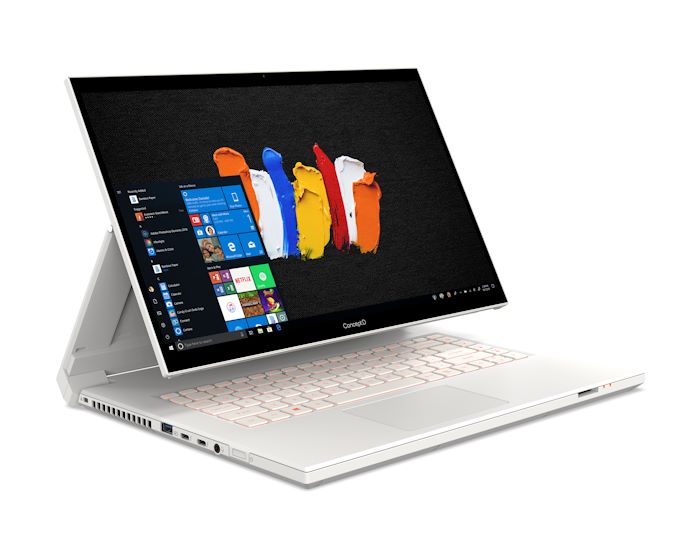Intel at CES 2020: 45W 10th Gen Mobile CPUs Soon, Tiger Lake with Xe Graphics Later
by Dr. Ian Cutress on January 6, 2020 1:00 AM EST- Posted in
- CPUs
- Intel
- Trade Shows
- 45W
- 10nm
- Core-H
- Tiger Lake
- Xe
- 10th Gen Core
- Comet Lake
- CES 2020

As we move into 2020, there is a lot of talk about what Intel’s 2020 plans will be. Discussions about the expansion of Intel’s 10nm process node products, such as Ice Lake, beyond the mobile platform are often very heated, especially when we have limited information out of the company directly. For CES 2020, Intel has disclosed a couple of products for consumption: moving its 10th Gen mobile CPU line in to 45 W hardware, but we also had a couple of details about the post-Ice Lake hardware, called Tiger Lake.
With the 45 W mobile CPUs, it’s important to note that we are talking about Comet Lake here – Intel’s latest 14++ nm microarchitecture derived from the original Skylake but optimized from the latest Coffee Lake hardware. What this means for users is essentially a small improvement in frequency: Intel isn’t saying that much with what the new CPUs will bring at this point, but they are pointing out that they will be hitting 5.0 GHz with the new 45W Core i7 parts, and more than 5.0 GHz with the Core i9 hardware. I would assume this would mean that Intel is going to introduce both Turbo Boost Max 3.0 and its Velocity Boost technology to the mobile platform, which would target the best cores in the chip as well as use additional thermal headroom to get that extra frequency. Intel did not disclose if the turbo power increases with the new hardware.
We’ve seen a couple of designs already announce they will be using the 45W CPUs: Acer’s ConceptD Ezel and Ezel Pro laptops, along with Lenovo’s Y740S gaming laptop. Intel has stated that it expects its hardware to be in the market soon, with a full disclosure about the platform ‘very soon’, however it turns out that this won’t be in January. To be honest, if we’re so close to launching the product, I’m surprised as to why Intel isn’t disclosing.
The other part to Intel’s disclosure at CES is Tiger Lake. What is Tiger Lake, you may ask – it’s the next mobile platform beyond Ice Lake. Bearing in mind that Intel has been speaking about Ice Lake a while, and we now finally have top tier partners with 1065G7 designs, we’re still waiting for Intel’s mid-tier and lower-tier partners to come out with the platform. So we’re still a long way away from Tiger Lake, unless Intel wants to move beyond Ice Lake quickly.
However, regarding Tiger Lake specifically, Intel did confirm that it has Xe graphics. Whether this is related to the DG1 silicon that the company has spoken about recently isn’t clear, but Tiger Lake is monolithic and the Xe graphics inside will provide full INT8 support for AI workloads (which will be supported through Intel DL Boost). This would be built on the Xe-LP microarchitecture, which is targeting sub-25W power on the GPU. Tiger Lake also continues with AVX-512, but also upgrades the Gaussian Neural Accelerator for voice analysis to GNA 2.0. Intel will say more about Tiger Lake at its press event on Monday.
Intel also briefed us about its new Ghost Canyon NUC 9 kit, which uses Intel’s upgradeable element form factor as well as an 8-inch desktop GPU. The NUC is a full 5.0 liter size, which completely ignores the original NUC size that the platform was built on, however Intel is claiming 9th Gen 45W CPU support up to 5.0 GHz, with upgradeable units coming later. We have a separate article on this.
Carousel image is the Acer ConceptD 7 Ezel, one of the new laptop designs using the new 10th Gen Core H-Series CPUs.













57 Comments
View All Comments
Chaitanya - Monday, January 6, 2020 - link
Another year of suffering from Blue Giant.nandnandnand - Monday, January 6, 2020 - link
Today is AMD's day, and 2020 is AMD's year.Chaitanya - Monday, January 6, 2020 - link
I really hope AMD can make meaningful inroads into HPC/Server/DC market which will really put Intel under pressure.prisonerX - Monday, January 6, 2020 - link
It already has.eSyr - Monday, January 6, 2020 - link
Why? IBM is doing relatively well.tipoo - Monday, January 6, 2020 - link
Not really, a slow decline buoyed by buybacks.yannigr2 - Monday, January 6, 2020 - link
5GHz with the 45W part. Like the 95W TDP 9900K that can go up to 210W based on Intel's internal document. Or the 125W 10900K that can go up to 250W.Irata - Monday, January 6, 2020 - link
The question is how much further can they go on binning and improving their 14nm process.Maybe they can deactivate part of the cores to get one to boost to 5 Ghz while staying reasonably within the power envelope, but I doubt this will suffice.
yeeeeman - Monday, January 6, 2020 - link
One core at idle speeds consumes very little power on my 6700HQ, under 0.15W. So the problem is the core that goes to 5Ghz, not the other ones. I think they can extract a bit more from it, but nothing spectacular, just enough to stay afloat.Another thing that we can learn from this very long period on 14nm is that throw away a bit too quickly very good processes that can be improved in time. Just compare how 5775C behaved and its limitations compared to what Intel has today.
Irata - Monday, January 6, 2020 - link
I think it's pretty amazing what Intel got out of their 14nm process.The danger here is that a very highly optimized mature process may make the following one(s) that are not yet optimized look bad in comparison.